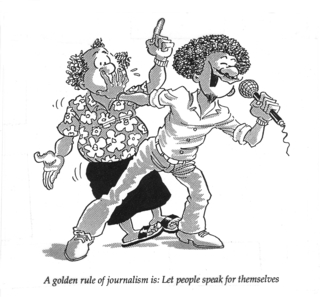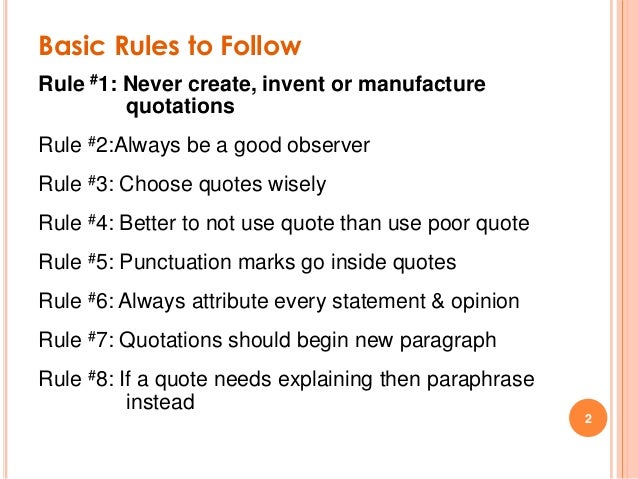Attribution is stating who said something. Attribution is essential in all the media, including radio and television. Journalists do it so that your readers or listeners can know who is speaking or where the information in the story comes from. You can use attribution for both spoken and written information, so that you attribute information gathered from interviews, speeches, reports, books, films or even other newspapers, radio or television stations.
The source can be a person, publication, or other record or document that gives timely information. Outside journalism, sources are sometimes known as "news sources". Examples of sources include official records, publications or broadcasts, officials in government or business, organizations or corporations, witnesses of crime, accidents or other events, and people involved with or affected by a news event or issue.
Examples:
SOURCE (PARAPHRASE) - Jeb Jones, a resident of the trailer park, said the sound of the tornado was terrifying.
SOURCE (DIRECT QUOTE)- “It sounded like a giant locomotive train coming through. I’ve never heard anything like it,” said Jeb Jones, who lives in the trailer park.
Reporters often use both paraphrases and direct quotes from a source. Direct quotes provide immediacy and a more connected, human element to the story.
Quotations: In complete quotations, attribution is set off from the quote by a comma. (“I'm busy," she said. Or: She said, “I'm busy.”) Because complete quotes are sentences in their own right, the quoted material begins with a capital letter. Never use orphan quotes (when the reader or listener is not sure who's doing the talking). Always attach attribution to a quote.
Long quotes: Occasionally a long quote, particularly a formal one, such as from the text of a speech, will begin a paragraph. That construction calls for attribution in the previous graph, which must close with a colon.
Partial quotes: By definition, partial quotations and quote fragmentsare not complete sentences. Attribution in those rarely used devices is not set off by commas and the quoted material does not start with a capital letter.
TYPES OF ATTRIBUTION.
1. On the record: All statements are directly quotable and attributable, by name and title, to the person making the statement. This is the most valuable type of attribution.
Example: "The U.S. has no plans to invade Iran," said White House press secretary Jim Smith.
2. On Background: All statements are directly quotable but can't be attributed by name or specific title to the person commenting.
Example: "The U.S. has no plans to invade Iran," a White House spokesman said.
3. On Deep Background: Anything that is said in the interview is usable but not in a direct quotation and not for attribution. The reporter writes it in his own words.
Example: Invading Iran is not in the cards for the U.S.
4. Off the Record: Information is for the reporter's use only and is not to be published. The information also is not to be taken to another source in hopes of getting confirmation.
WHEN TO ATTRIBUTE
Any time the information in your story comes from a source and not from your own firsthand observations or knowledge, it must be attributed. A good rule of thumb is to attribute once per paragraph if you are telling the story mainly through comments from an interview or eyewitnesses to an event. It might seem repetitive, but it’s important for reporters to be clear about where their information originates.
One of the greatest dangers facing young journalist is accepting what people say as the truth. Just because someone tells you that something is a fact does not make it so. If you attribute the words to the person who said them, you do not have to prove or disprove the truth of their words; you simply report them. Also, people judge what is said by the person who says it. Statements made by people in authority carry more weight than statements made by other people.

ETHICS
Attribution is a journalist's way of sourcing the
information in their piece. This can come from all different ways, including
quotes to paraphrasing. Any information that is provided outside of a
journalist's personal observations needs to be properly attributed in any type
of article. This prevents any fraud, copyright infringements, and helps the
writer be clear and precise about their data.
Journalists ethical code normally address the issue of
attribution, which is sensitive because in the course of their work journalists
may receive information from sources who wish to remain anonymous. Divulging
the identity of a confidential source is frowned upon by groups representing
journalists in many democracies. In many countries, journalists enjoy the same
protection under the law as all other citizens, and as such may be required to
divulge their sources in the course of a criminal investigation as any other
citizen would be. Even in jurisdictions which grant journalists special legal
protections, journalists are typically required to testify if they bear witness
to a crime.

RELIABLE SOURCES
In some cases, your sources of information may not
want to be named, for fear of revenge. Journalists who are sure of their facts
often attribute such information to "usually reliable sources",
"informed sources" or "sources within the
department/company".
In some cases, they use phrases like "it is
widely believed that" or "it is understood that". Be warned! If
your information is wrong, the blame will rest at your door. The greatest
danger comes in "off the record" interviews. You must always consult
your news editor or chief of staff about what you can and cannot say in such
cases. (See Chapter 59: Sources of information.)
TO SUMMARISE:
• Always attribute quotes to the speaker or source of
information.
• You can use alternative words to "said",
but beware that they may have distinct meanings and may imply support or
disbelief.
• Attribute all opinions and information which is not
a clear and undisputed fact.
(SOURCES – Open school of journalism, The news
manual, Wikipedia, Thoughtco., Web.cu.ed)
-Ishita Sharma, Student of Journalism, LSR


1 comment:
Comment on Attribution
•The article is holistic in the sense that everything from definitions, to types of attribution, to examples, to ethics is given. It provides a complete picture.
•”Types of Attribution” is a topic which is crystal clear, this is because of the use of EXAMPLES to explain on the record, off the record, on background and on deep background. These clear demarcations drawn in the article promote the reader’s understanding both as a prospective journalist or as a prospective source.
•A closer look at the sub topics “Ethics” and “When to Attribute” move from basic to a more professional and critical terms of journalism. A person is enabled to gather the simple concepts and rule of thumbs, at the same time they are made aware of the technicalities and legalities involved in the practice of attribution
Mahi Adlakha
(22/0959)
Post a Comment